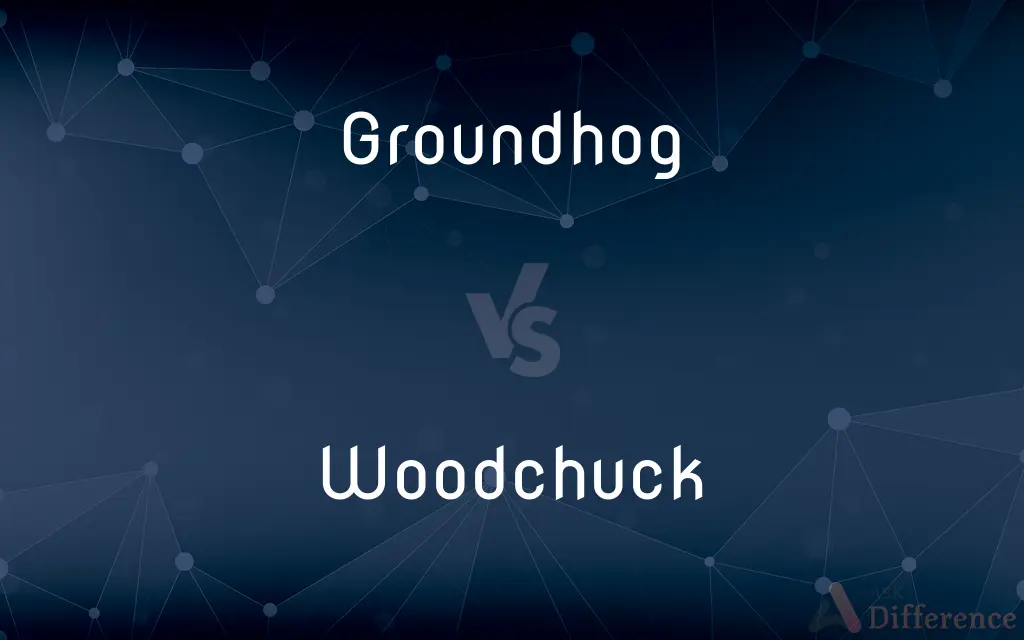Groundhog vs. Woodchuck — What's the Difference?
By Tayyaba Rehman — Updated on September 23, 2023
Groundhog and Woodchuck are two names for the same animal, a rodent of the marmot family.

Difference Between Groundhog and Woodchuck
Table of Contents
ADVERTISEMENT
Key Differences
The terms Groundhog and Woodchuck refer to the same creature, a midsized rodent that belongs to the marmot family. While the name Groundhog emphasizes the animal's burrowing habits, living mostly on or under the ground, the name Woodchuck doesn't have a direct connection to wood but is believed to derive from the Algonquian name for the animal, "wuchak."
Groundhogs and Woodchucks are known for their hibernation habits. Every year, there's a famous tradition on Groundhog Day where the Groundhog (or Woodchuck) emerges, and its shadow is used to predict the coming of spring. Regardless of the name used, this tradition is well-entrenched in American and Canadian folklore.
The physical characteristics of the Groundhog and Woodchuck remain consistent, regardless of the terminology. They have sturdy bodies, short legs, and small ears, making them well-adapted to a burrowing lifestyle. When referring to this animal in scientific studies or in literature, the terms can be used interchangeably.
Though "Groundhog" tends to be the more popular term, especially in reference to Groundhog Day, "Woodchuck" is equally accurate. Different regions and cultures might have a preference for one name over the other, but both terms are understood universally, at least within North America, to denote the same furry, burrowing creature.
Comparison Chart
Definition
A midsized rodent of the marmot family.
Another name for the same rodent.
ADVERTISEMENT
Name Origin
Named for its burrowing habits.
Derived from the Algonquian name "wuchak".
Associated Tradition
Groundhog Day.
Same as Groundhog Day, just another name.
Common Usage
More popular due to the Groundhog Day tradition.
Less commonly used than Groundhog.
Cultural Recognition
Recognized universally in North America.
Recognized, but to a lesser extent than Groundhog.
Compare with Definitions
Groundhog
Member of the marmot family.
The Groundhog shares characteristics with other marmots.
Woodchuck
Derived from Algonquian "wuchak".
The name Woodchuck has Native American origins.
Groundhog
Hibernates during winter.
The Groundhog is asleep during the colder months.
Woodchuck
Celebrated on Groundhog Day.
Some people might say Woodchuck instead of Groundhog on February 2nd.
Groundhog
Found primarily in North America.
The Groundhog's habitat ranges across many parts of North America.
Woodchuck
Another name for the burrowing rodent, Groundhog.
The Woodchuck is notorious for digging up gardens.
Groundhog
A rodent known for its burrowing habits.
The Groundhog dug a complex tunnel system in the backyard.
Woodchuck
Part of the marmot species.
The Woodchuck's close relatives include other marmots.
Groundhog
Associated with the Groundhog Day tradition.
On Groundhog Day, the Groundhog's shadow predicts spring's arrival.
Woodchuck
Known to hibernate.
A Woodchuck will typically retreat to its burrow for winter hibernation.
Groundhog
The groundhog (Marmota monax), also known as a woodchuck, is a rodent of the family Sciuridae, belonging to the group of large ground squirrels known as marmots. The groundhog is a lowland creature of North America; it is found through much of the eastern United States, across Canada and into Alaska.
Woodchuck
A large burrowing rodent (Marmota monax) of northern and eastern North America, having a short-legged, heavyset body and grizzled brownish fur. Also called groundhog; also called regionally whistle pig.
Groundhog
Another term for woodchuck
Woodchuck
A rodent of the family Sciuridae, belonging to the group of large ground squirrels known as marmots, Marmota monax.
Groundhog
See woodchuck.
Woodchuck
A common large North American marmot (Arctomys monax). It is usually reddish brown, more or less grizzled with gray. It makes extensive burrows, and is often injurious to growing crops. Called also ground hog.
Groundhog
A red-brown marmot, Marmota monax, native to North America.
Woodchuck
The yaffle, or green woodpecker.
Groundhog
(rare) The aardvark.
Woodchuck
Reddish brown North American marmot
Groundhog
A reddish brown North American burrowing marmot (Marmota monax), also called the woodchuck. It hibernates in the winter.
Groundhog
Reddish brown North American marmot
Common Curiosities
Do Groundhogs really predict the weather?
The Groundhog Day tradition is folklore; there's no scientific basis for the prediction.
Is a Woodchuck different from a Groundhog?
No, they are two names for the same animal.
Why is it called Groundhog Day?
The tradition is based on the animal's emergence from its burrow on February 2nd.
What is the lifespan of a Groundhog?
In the wild, they typically live 3-6 years.
What is a Groundhog?
A Groundhog is a midsized rodent known for burrowing, part of the marmot family.
Why are they called Woodchucks?
The name derives from the Algonquian term "wuchak."
Where can you find Groundhogs or Woodchucks?
They are native to North America.
Do Woodchucks chuck wood?
No, the name doesn't reflect their behavior or diet.
Are Groundhogs and Woodchucks aggressive?
They are generally shy but can be aggressive if cornered.
How long do Groundhogs hibernate?
They hibernate during the winter months.
What do Groundhogs eat?
They primarily eat plants, grasses, and occasionally insects.
Where did the Groundhog Day tradition start?
It has roots in ancient European weather lore, but was popularized in America.
What predators do Groundhogs have?
They can be preyed upon by animals like foxes, eagles, and coyotes.
Share Your Discovery

Previous Comparison
Hamlet vs. Village
Next Comparison
Ureter vs. UrethraAuthor Spotlight
Written by
Tayyaba RehmanTayyaba Rehman is a distinguished writer, currently serving as a primary contributor to askdifference.com. As a researcher in semantics and etymology, Tayyaba's passion for the complexity of languages and their distinctions has found a perfect home on the platform. Tayyaba delves into the intricacies of language, distinguishing between commonly confused words and phrases, thereby providing clarity for readers worldwide.














































